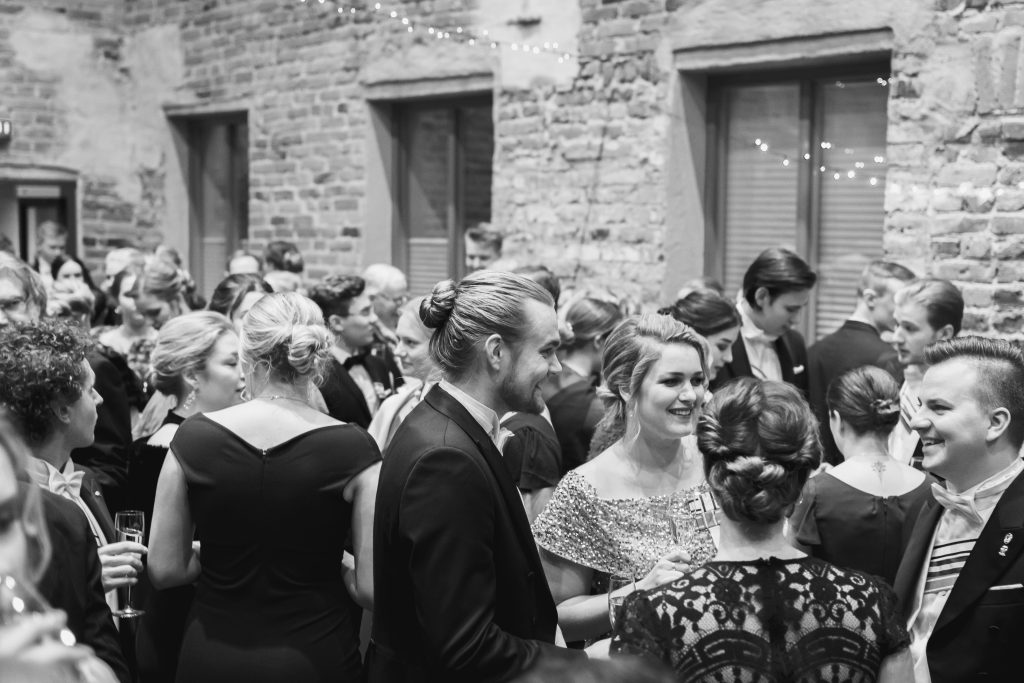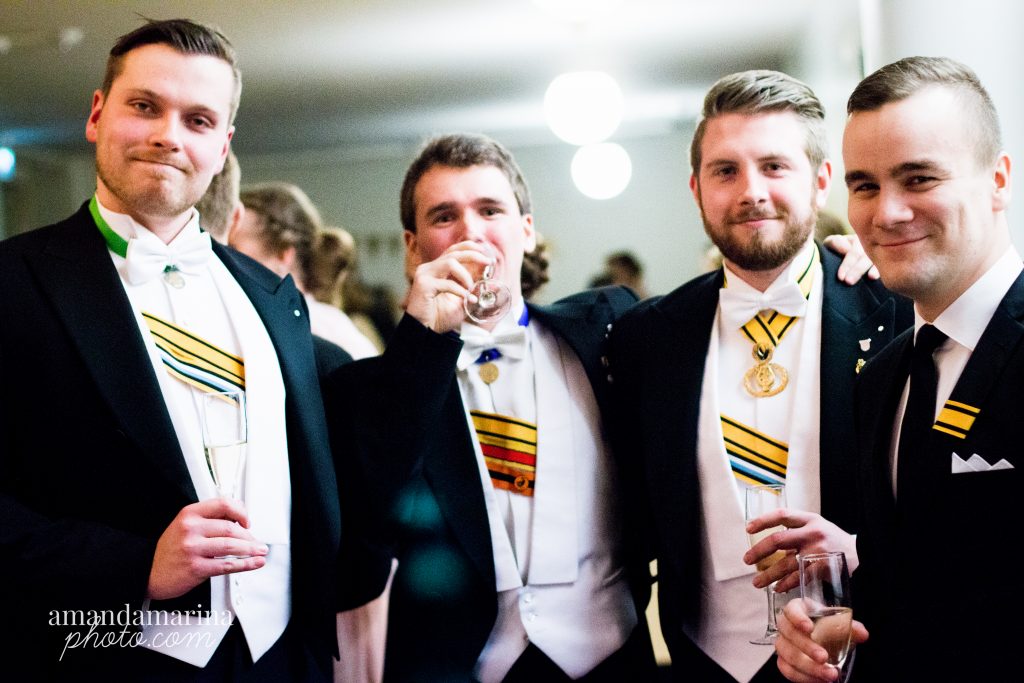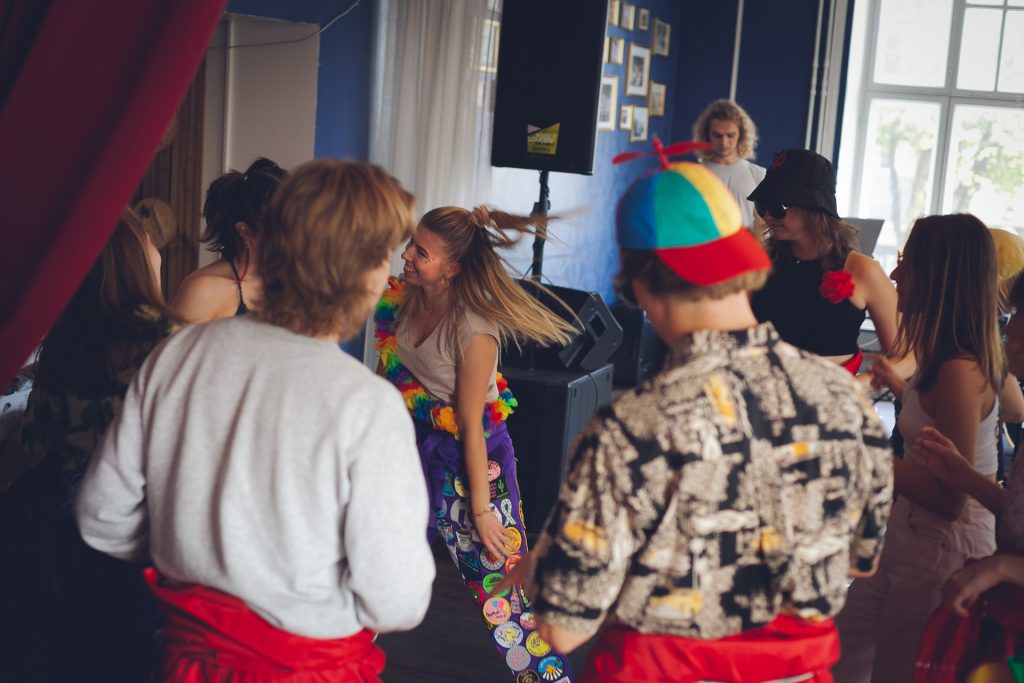The Annual Ball
ÅAS CV
ÅAS CV was celebrated on Saturday 17.2.2024 in Åbo at restaurant Kåren (Hämeenkatu 22). We want to send our warmest thank yous to all who participated in the festivities!
Etiquette
On the way to a party!
This is a small collection of tips on knowledge and etiquette. It is written primarily to give a picture of the rules for the annual balls of Åbo Akademi University. The rules and tips are there to be followed but it is always possible to use common sense. It is always nicer to go to a party if you know how to behave and are well prepared.

Dress code
At an anniversary party, you do not wear clothes, you wear an outfit. Start by reading the invitation, which states what the dress code for the party is. For most annual balls or other events, festive attire with academic arrangements applies. In practice, this means a white tie or dark suit / long dress. Academic badges of distinction, nation band, etc. are being worn in with the outfits. The white tie or long dress can in any context be replaced with a folk costume.
White tie
White ties are used at academic parties, formal evening occasions, and academic day events (e.g., dissertations and promotions). The white tie consists of a black tailcoat and black trousers with black lapels. The tailcoat is accompanied by a white dress shirt, white bow tie, and white waistcoat.
The big problem with the tailcoat is the buttons because they are removable, i.e., easy to both lose and forget. Small tailcoat buttons are usually used for the white dress shirt, but these can be replaced with special buttons (e.g., associations can have buttons with their own seal).
For white ties, black, long socks are worn, so long that the leg is never visible. The shoes should also be black, they should be festive, and the material is either leather or patent.
Accessories
Remember the goloshes if the weather is bad and you don’t want wet feet all evening. When you are outdoors, you can wear a long dark coat or a festive dark cape on top of the white tie.
The scarf should always be white. White gloves and a black hat can also be worn. These are worn together or not at all. When entering the ballroom, these are left in the cloakroom; no hats in the banquet hall!
You do not wear wristwatches with a white tie. Instead, you can, e.g., have a pocket watch.
Dark suit
The dark suit is black or dark blue. For the dark suit, wear a white shirt and a discreet tie (forget the Hawaii pattern and South Park).
As for shoes and socks, the rule is the same as when wearing a white tie. With a dark suit, you can wear a watch but not white gloves.
Evening dresses
There are both evening dresses and ball dresses, but the main thing is that the dress is below the knees and that it is dignified. Traditionally, the dress should reach all the way down to the shoe so that the calves are fully covered. It does not matter what colour or material the dress is made of, the main thing is that it is festive. The length of the dress can vary from sleeveless to long sleeves.
Traditionally, shoulders are kept covered until the evening programme begins, i.e. until you sit down at the table. You can cover your shoulders with a shawl, bolero or other festive jacket.
Accessories
Evening dresses go well with gloves, which can be long or short and in almost any colour. The shoes are festive heels or sandals. However, remember that it is wise to wear comfortable shoes to make dancing more fun. We recommend a small and convenient handbag.
If you want to wear a watch, it should be discreet and festive. You can choose jewellery according to your own taste. Remember that bracelets and rings are worn on top of gloves (except for engagement and wedding rings). A formal hairstyle should be worn with the dress; the rule is that the neck should be visible when the hair is up, but if you prefer to have your hair down it is of course up to you. The hairstyle can be further embellished with buckles, ribbons or flowers whether up or down. Ladies do not wear a headdress at evening events unless it is part of a folk costume.

Nation bands, medals, and other attachments
You wear bands with your costume to show which organisations you belong to. These bands are student union bands, nation bands, and bands of other associations. By the colours, you can recognize which organizations it belongs to. With the white tie, the bands are being worn under the vest, diagonally from the right shoulder down to the left side. The bands should be between the second and third buttons of the dress shirt.
With a dark suit, the ribbons are worn on the jacket flap.
With long dresses, the bands are worn like a bow. The bow is attached to the dress at the left breast. Different organizations fold their bows differently, check it out in advance.
Here you can see how the rosette is folded at ÅAS.
In case the colours of the bands are asymmetrical, the ”heavier” colours should be turned downwards.
Awards, honours, and commemorative badges are worn on the left side unless otherwise determined for a specific badge. Åbo Akademi Student Union’s badge of distinction is affixed to the union band or bow. If you wear several bands or bows, they are worn in ”order of magnitude”. The bands of the student union are worn at the top, followed by those of nations, and at the bottom of other associations. It is wise to check the order of precedence of the different awards in advance.
Banquet
Cocktail and seating arrangement
The banquet usually begins with cocktails. During the cocktails, you can walk around and get acquainted with the other guests as well as the seating arrangement. This is usually posted on a wall or distributed as a printed handout. Depending on the seating arrangement, your table companion may be someone you don’t yet know. Consider each other and help each other out. No one enters the hall until the Marshal announces that dinner is served.
The guests of honour are mostly seated at the honourary table. These guests are the last to enter the hall and are usually introduced to the guests as they enter. You should, therefore, have entered the room before them.
Before dinner
When you have entered the ballroom and found your place at the table, you stand behind your chair and wait until the guests of honours have been knocked in and the banners have been raised. The banners are carried in as soon as the guest of honours arrives. Turn so that you follow the course of the Finnish flag when it is carried in. Remember to introduce yourself to your table companion.
Once seated at the table, you do not get up until the main course has been served. Ideally, you should not get up from the table at all before the entire dinner has been eaten unless it is directly ’necessary’. If it becomes ’necessary’, you should move very discreetly. Do not leave the room when someone is speaking, or another programme is going on. The same applies when you return. If a speech is going on, do not come in and steal the show, instead it is polite to wait outside until the programme is finished.
Songs and speeches
The song leader has a very important role at the annual ball. It is the song leader who decides when and what song is sung. Only the song leader has this right. There are times when individual guests may start on a song, but never without the permission of the song leader. When the song leader has the word, everyone else is silent. The same applies when the marshal is speaking or when someone is giving a speech. These should be respected. You also do not eat when speeches are made, but if you get thirsty, you can discreetly take a sip.
Conference
The conference is a break of x minutes. During the conference, the guests have time to go to the toilet, get more refreshments for the table or take a walk outside. Follow the marshal’s instructions for what applies to the conference.
At the dining table
Did you remember to inform the organisers of any special diets when you registered?
The First Course
Once everyone is seated, the song leader and other important information for the ball are introduced. The Student Union Trustee or song leaders start with Helan, which begins the first course. After each snaps song, a toast is made.
This is done in the following way: You raise the snap glass, but not up into the skies. At the same time, you turn to the person sitting diagonally across the table to your left, look them in the eyes, nod and say ”skål”. The same procedure is done with the person sitting across the table to your right and then with the person sitting opposite you. After that, you drink.
Now you can start eating. For the first course, use the cutlery that is placed at the far end of the plate. In addition to snaps, beer and possibly wine are usually drunk with the starter; water can and should be drunk at any time during the dinner. Beer is drunk from the glass in front of the beer bottle. The glasses are placed in front of the plate in the order in which they are to be used from right to left.
At many annual balls, the second snaps is served immediately after Helan is sung. The snaps glass is refilled and if you have not finished the first one, you can pour it into the coffee mug so that you get a full refill.
The main course
For the main course, you should not drink snaps (there are too many snap songs in any case). However, wine is served. Wine is accompanied by wine songs, but unlike snaps, you can drink wine even when it has not been sung. The main course is eaten with the cutlery closest to the plate and you can start eating when the people who sit closest to you have received their food.
Dessert
Dessert can vary greatly and cause problems. The dessert is eaten with the dessert cutlery found above the plate: fork, spoon, or both depending on what is served. Decorative biscuits etc. may be eaten by hand. The main desserts causing problems are, e.g., slippery fruits, but the only solution is caution. Sometimes dessert wine is served.
Coffee
The coffee is served either with or without the dessert. The coffee is served with punch, cognac, or some liqueur; in a student context, it is usually punch.
When dinner is over and the coffee is also finished, the banquet ends with ”O gamla kling och jubeltid”. The second verse of the song (beginning with ”På mössan ligger…”) is often included in the songbook but must never be sung in peacetime. During the last verse, you should stand up, and after that, you are not allowed to sit down again.

After dinner
Dance
Sometimes there is a dance card at your place, then you write down which dance you want to dance and with whom. You should dance the first dance with your table companion, then with the person sitting on your other side and then with the person sitting across from you. As a rule, two dances (one after the other) should be danced with the same person, even though it is only called one dance.
Night food
If the ball has started early, the night will be long and then it may happen that night food is served. A classic is pyttipanna (hash). The night food is usually served just before or at the after-party.
Afterparty and herring breakfast
The nachspiel and herring breakfast (sillis) belong to the more unofficial parts of the annual ball. The nachspiel begins after the banquet is over and is an afterparty.
The sillis starts the day after the ball at noon and you may come dressed however you like, usually this means your overall, a hat and sunglasses.
Registration
Registration will open closer to the annual ball